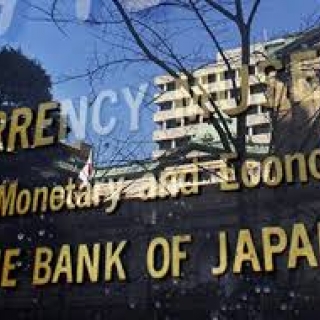


The Bank of Japan (BoJ) is widely expected to leave short-term interest rates unchanged at 0.5% after its two-day June monetary policy review ends on Tuesday (6/17).
With no quarterly economic projections due, all eyes will be on the BoJ's plan to taper its purchases of Japanese government bonds (JGBs) and hints on the timing of its next rate hike. The BoJ's policy announcement is likely to fuel volatility around the Japanese yen (JPY).
What to expect from the BoJ's rate decision?
The BoJ is set to extend the pause in its rate-hike cycle to a third straight month in June, keeping its polic rate at its highest level in 17 years.
At its April 30-May 1 policy meeting, the Bank of Japan stuck to its rhetoric that it "will continue to raise interest rates if the economy and prices move in line with expectations."
The bank also pointed to a more volatile outlook due to U.S. trade policy: "Uncertainty about the impact of tariffs on the economy remains high even after tariffs are finalized."
Since then, trade tensions have eased, thanks to a US-China truce and the prospect of US trade deals with Japan and the European Union (EU).
"If trade negotiations between the countries continue and uncertainties over trade policies ease, overseas economies will resume a moderate growth path. That, in turn, will accelerate Japan's economic growth," Ueda said in a speech earlier this month, keeping alive hopes for another rate hike by year-end.
As such, markets expect BOJ chief Ueda to lean slightly hawkish when he talks about the rate outlook during his post-policy meeting press conference at 6:30 GMT.
In addition, concerns over stubborn food inflation, particularly due to rising costs of Japan's staple rice, could prompt Ueda to deliver a hawkish message.
"Japan is now experiencing a second wave of food price inflation driven by supply shocks, which are adding to the inflationary momentum from higher wages," Ueda said previously.
Japan's core consumer price index (CPI) inflation has exceeded the BoJ's 2% target for more than three years and hit a more than two-year high of 3.5% in April, driven largely by a 7% jump in food prices, according to Reuters.
In addition to the BoJ's communication on its next interest rate move, markets will also be watching the central bank's assessment of its current plan to reduce the bank's JGB holdings by JPY400 billion per quarter.
The BoJ is considering halving the pace of quarterly reductions in JGB purchases to JPY200 billion ($1.4 billion) starting in April 2026, according to a report by the Nikkei Asian Review on Saturday.
The BoJ's tapering plan is expected to be supported by a majority of policy board members, the Nikkei added.
The potential for a reduction in the central bank's stimulus tapering plan remains important given the recent volatility in the bond market, when the 40-year JGB yield hit an all-time high. (alg)
Source: FXstreet
Japan's annual inflation rate edged down to 2.9% in November 2025 from October's 3-month high of 3.0%. Core inflation stood at 3.0%, keeping the same pace as in October and aligning with estimates. Mo...
Goldman Sachs sees gold prices climbing 14% to $4,900 per ounce by December 2026 in its base case, it said in a note on Thursday, while citing upside risks to this view due to a potential broadening o...
The BRICS group of countries is increasingly being considered as an alternative for global diplomacy and cooperation amidst increasing tariff and protectionist policies from the United States. A numbe...
Applications for US unemployment benefits fell after a spike in the previous week, underscoring the choppy nature of the data at this time of year. Initial claims decreased by 13,000 to 224,000 ...
Annual inflation in the United States (US), as measured by the change in the Consumer Price Index (CPI), fell 2.7% in November, according to a report by the US Bureau of Labor Statistics (BLS) on Thur...
US stocks closed sharply higher on a triple-witching Friday, with the S&P 500 rising 0,9%, the Nasdaq 100 gaining 1.4%, and the Dow Jones adding more than 180 points, extending gains from the previous session as technology stocks...
European equities closed higher on Friday, with the STOXX 50 up 0.6% and the STOXX 600 rising 0.4% to a fresh record, boosted by expectations of further Fed rate cuts next year and fading bets that the ECB will raise borrowing costs in...
Gold (XAU/USD) Gold (XAU/USD) regains ground on Friday, edging modestly higher after earlier weakness, even as a resilient US Dollar (USD) caps upside momentum. At the time of writing, XAU/USD trades around $4,345, recovering from a daily low near...
 Fed Governor Christopher Waller said Wednesday that the Fed is in no rush to cut interest rates, given the current outlook, according to...
Fed Governor Christopher Waller said Wednesday that the Fed is in no rush to cut interest rates, given the current outlook, according to...
 The Bank of Japan (BOJ) is expected to raise interest rates on Friday to a three-decade high, from 0.5% to 0.75%, signaling readiness for further...
The Bank of Japan (BOJ) is expected to raise interest rates on Friday to a three-decade high, from 0.5% to 0.75%, signaling readiness for further...
 European stocks finished in positive territory on Thursday as traders positioned for central bank decisions today.
The pan-European Stoxx 600 was...
European stocks finished in positive territory on Thursday as traders positioned for central bank decisions today.
The pan-European Stoxx 600 was...
 The United States ordered a blockade of Venezuelan oil tankers because the Trump administration believes President Nicolás Maduro's regime is acting...
The United States ordered a blockade of Venezuelan oil tankers because the Trump administration believes President Nicolás Maduro's regime is acting...